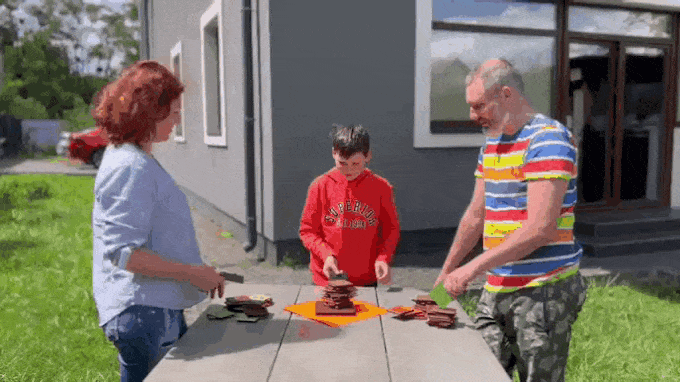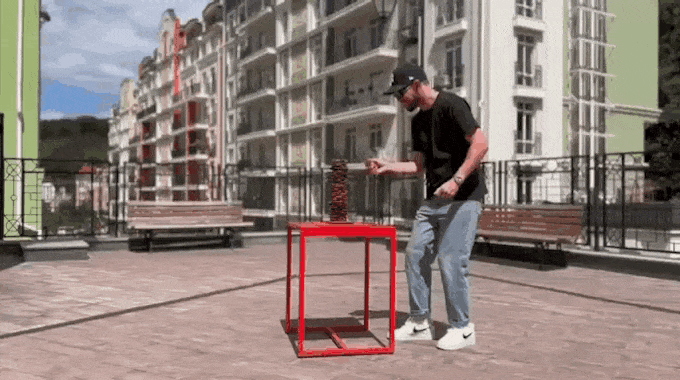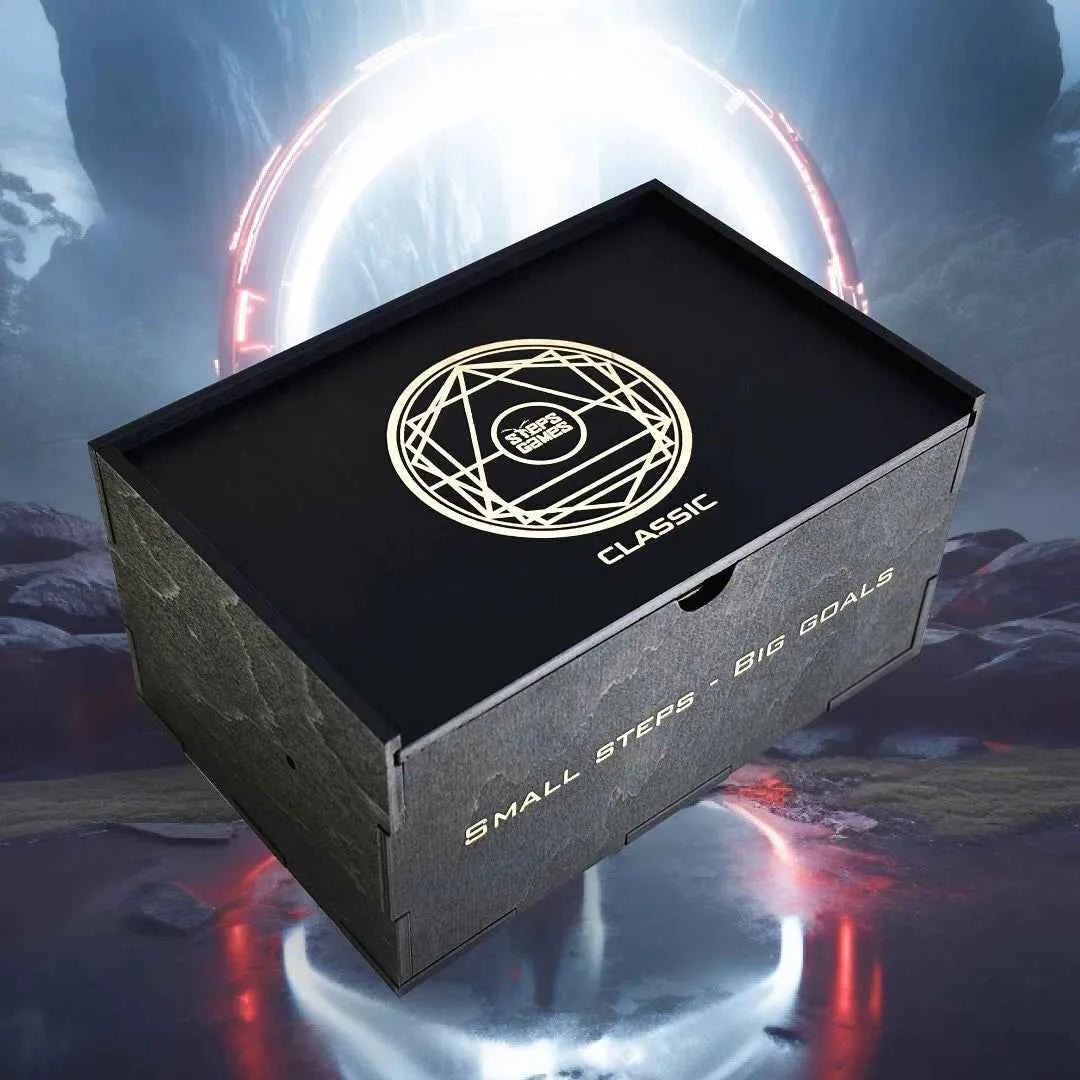




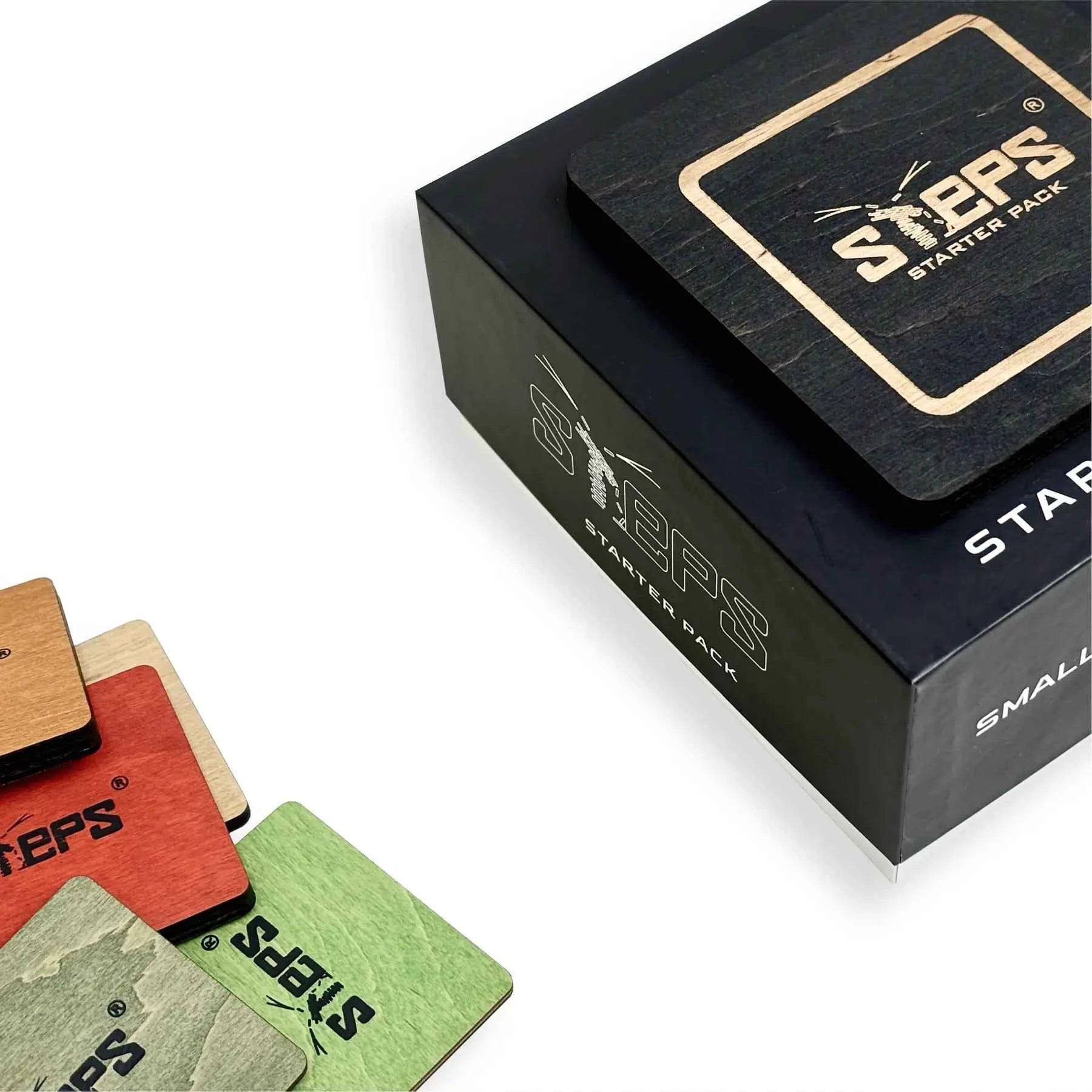






Board game Steps Starter Pack 1-6 Players 48 Squares
Pickup currently unavailable at Salaspils

Board game Steps Starter Pack 1-6 Players 48 Squares
Salaspils
3 Enerģētiķu iela
Salaspils 2121
Latvia
Shipping available worldwide!

The color indicates thickness and weight

- Light and dark green — the lightest;
- Brown and dark brown — standard;
- Orange and red — the heaviest (Bambula).
- Playing platform
- Storage and carrying bag for taking the game with you
- Rules
Players decide for themselves which square to throw in different situations, depending on whether the structure on the platform is wobbly or stable. It's all up to you!
Board game Steps
STEPS is a super fun and exciting dexterity game where you need to get rid of wooden squares by throwing them one by one onto the playing platform! Adrenaline, intense emotions, good mood, and "let's play again" — all of this awaits you with this game!
If you enjoy active games where you need to use not only your hands but also your logical thinking to outsmart your opponent, we guarantee that STEPS is the game for you! Gather a group of friends or have fun with the whole family. Steps is a game that will appeal to children, teenagers, and adult players alike. You can even play STEPS alone!
Mini (1-4 Players)

- 32 Stepses -
- 8 Light (Green/Dark green),
- 16 Standard (Brown/Dark brown)
- 8 Heavy (Orange/Red)
- Game Platform
- Rules
- Travel Bag
Starter Pack (1-6 Players)

- 48 Stepses - 12 Light (Green/Dark green)
- 24 Standard (Brown/Dark brown)
- 12 Heavy (Orange/Red)
- Game Platform
- Rules
- Travel Bag

Place the box in the center of the table and distribute squares equally among the players. You take turns throwing squares onto the gaming platform, aiming for your square to touch the opponent's previous square either in flight or upon landing.
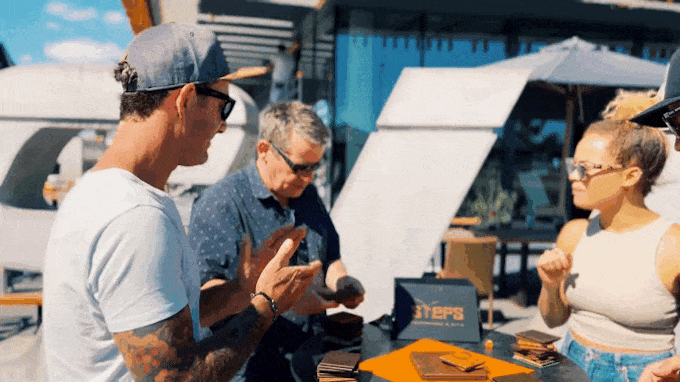
If a square falls off the playing platform, the player who threw it takes both the fallen square and any others that may have dropped. The next player can throw their square anywhere on the platform or at any of the squares on it.

Forget building towers; we're all about tossing squares strategically, making creation collapse in your opponent’s turn faster than a poorly constructed house of cards. You play with 3 squares types! Using different squares in different situations is key to the strategy and victory. The winner is the first one to get rid of all their squares.
Place the box in the center of the table and distribute squares equally among the players. You take turns throwing squares onto the gaming platform, aiming for your square to touch the opponent's previous square either in flight or upon landing.
If a square falls off the playing platform, the player who threw it takes both the fallen square and any others that may have dropped. The next player can throw their square anywhere on the platform or at any of the squares on it.
Forget building towers; we're all about tossing squares strategically, making creation collapse in your opponent’s turn faster than a poorly constructed house of cards. You play with 3 squares types! Using different squares in different situations is key to the strategy and victory. The winner is the first one to get rid of all their squares.



Instructions
1. Stepses are distributed to each player in equal quantities by color, where greenones are the easiest, brown ones are standard, and red ones are the hardest (Bambula).
2. The game starts with the player who won at "Rock, Paper, Scissors." The player takes any Steps at their own discretion and throws them onto the playing platform. (We recommend holding the Steps by the wider side during the throwing.)
3. It is forbidden to simply place the Steps or release it over the structure.
4. We recommend throwing the Steps with a downward-to-upward hand motion to ensure a trajectory that lands in the desired spot (similar to throwing a basketball into a hoop). If the Steps construction is stable on the playing platform, you can confidently throw the Bambula Steps. If the construction is wobbly and ready to collapse, it's better to use a lighter Steps. We recommend monitoring the angle of the construction (if the Stepses construction is tilted away from the player, it's better to throw from the opposite side - see point 8).
5. Steps must be thrown at a distance no less than the length of one Steps from the playing platform or the Steps of the opponent on the playing platform (the farther, the more interesting, but practice makes perfect). Upon landing, the Steps must touch the opponent's Steps (if it touches and bounces off to the side, it still counts as long as it touches). If it doesn't touch, see "Penalties".
6. If a Steps falls outside the playing field, the player takes it and any other Stepses that have fallen.
7. The next player can throw their Steps to any point on the game platform or onto any other Steps on the game platform.
8. You can throw your Steps by reaching across to the opponent's side, but without crossing over to their side.
9. Whoever’s turn it is when the Stepses fall outside the playing field must retrieve them. (Don't be too hasty with your throw, the Steps may fall at the end of your opponent's turn, and you'll have to retrieve them.)
10. If you have only one Steps left, you must throw it with a 180-degreeflip in the air. (Practice your throw by tossing the Steps in your hand first. If you're having trouble, watch the video on the QR code on the side of the box.)
11. If during your turn Steps lands on the edge, and you haven't violated any rules – it's almost a victory. Your opponent also gets a chance to land Steps on the edge. If they succeed, the game continues; if not, you win.
The winner is the first one to get rid of all their Stepses.Remember, you're not building a tower, you're creating a structure out of Stepses that will fall on your opponent's turn! (Refer to points 6 and 7 again.)
If the player violates the rules and the Steps falls off, they do not receive a penalty Steps (this doesn’t apply to point 1).All players give one of their Stepses (for example, a Bambula Steps) to the player who violated the rules as a penalty.
1. If the player threw out of turn.
2. If the player threw a Steps and it didn’t touch the opponent's Steps upon landing or in flight.
3. If the player threw a Steps and it didn’t touch any other Stepses or the game platform.
4. If the final throw was not executed with a flip and the Steps remained on the game platform.
5. If the player touches the construction with their hand (pushes the structure before the opponent's turn) or removes a Steps from the game platform.
Type 1 (Standard) — according to the rules described on the top:For 1 player:The player throws Stepses from any side onto the playing field until they run out. If the construction collapses, the player loses.(This rule is only for this type of game)For 2, 3, 4, 5, 6 players:Each player is given the same amount of Stepses, depending on the number of Stepses in the sets.Teams 2x2, 3x3, 2x2x2, 3x3x3:Each team is given the same amount of Stepses, depending on the number of Stepses in the sets.
2nd type of game:Same as the first type, but with added difficulty of performing a 180-degree flip in the air with every Steps throw (single flip), and the final Steps must be thrown with a 360-degree flip (double flip).
3rd type of game:Same as the second type, but with the added requirement of performing a flip in the air of at least 360 degrees (double flip) with every Steps throw, and the final Steps must be thrown with a flip of at least 540 degrees (triple flip).
4th type of game:Same as the first type, but before every throw, the player must roll a dice, and the number on the dice determines the number of Stepses to be thrown at once (the dice is not included in the set).
5th type of game:Combines the second and fourth type of game. Before every throw, the player rolls a dice, and the number on the dice determines the number of Stepses to be thrown with a 180-degree flip in the air, and the final Steps must be thrown with a flip of at least 360 degrees.
6th type of game:Combination of the 3rd and 4th types of game. Before each throw, a dice is rolled, and the number that appears on the dice determines the number of Stepses to be thrown at once with a 360-degree flip, and the last Steps must be thrown with a flip of at least 540 degrees.
7th type of game:A game with a timer. When the time on the timer runs out, the player or team with the fewer Stepses remaining becomes the winner. This type of game can be combined with any of the types, except for the game with a single player.
8th type of game:Silent Steps. In this type of game, Steps must be placed instead of thrown. It can be played by 2 to 6 players or teams. It can be combined with the 4th type of game with a dice and the 7th type of game with a timer. All rules and penalties are the same as in the regular game, except point 3 and for the last Steps, which must be placed on its edge and released to land on one of its sides.
























